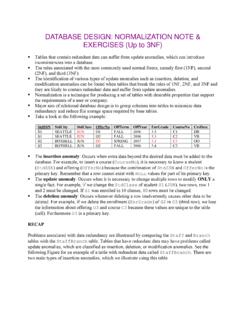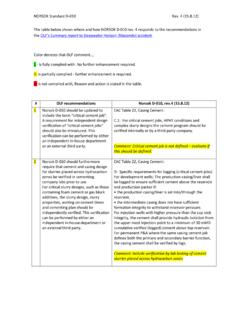Transcription of The Janda Approach to Chronic Musculoskeletal …
1 The Janda Approach to Chronic Musculoskeletal pain : Level 1 Prof Vladimir Janda MD, DSc ("yan-da") (1923-2002) was a Czech neurologist and physiatrist with over 50 years experience as a professor, researcher, and physician. He presented his clinical and research findings around the world, and is considered an expert in Musculoskeletal pain syndromes. Through his research and experience, he has defined characteristic patterns and syndromes of muscle imbalance that lead to Chronic pain and disability. Dr. Janda was considered the father of rehabilitation in Czech Republic and an integral part of the Prague School Approach to rehabilitation medicine. The sensorimotor system functions as one entity, integrating the central nervous system (CNS) and Musculoskeletal system.
2 The muscles are often a window to the function of the CNS. The CNS regulates two phylogenic subsystems: the tonic muscle group and the phasic muscle group. Each group of muscles has a predisposition for facilitation (tonic system) or inhibition (phasic system). Any change within the sensorimotor system (due to pain , pathology or adaptive changes) will be reflected by compensation or adaptations throughout the system. This leads to systemic and predictable patterns of muscle imbalance. Dr. Janda has defined the characteristic Upper Crossed Syndrome, Lower Crossed Syndrome, and Layer Syndrome. These muscle imbalances often lead to changes in movement patterns, most notably seen with hip extension, hip abduction, shoulder abduction, push-up, cervical flexion, and trunk flexion.
3 Functional pathology of the motor system is a term used to describe the importance of dysfunction, rather than structural lesions. Chronic Musculoskeletal pain , such as Chronic low back pain , sacroiliac dysfunction, shoulder impingement, anterior knee pain , or fibromyalgia, is often the result of functional pathology of the sensorimotor system with secondary structural inflammation. Systematic evaluation of posture, balance, gait, muscle length, movement patterns, and trigger points helps determine the extent of muscle imbalance and movement impairment. Once the specific patterns of imbalance and impairment have been determined, a specific exercise program is implemented. The general progression of treatment involves the normalization of peripheral proprioceptive structures, normalization of tight muscles, facilitation of inhibited or weak muscles, and finally coordination of movement patterns through specific exercise.
4 Muscles must be trained reflexively to restore normal firing patterns, speed, and coordination with other movements. Dr. Janda 's unique Sensorimotor Training (SMT) program is the basis for restoring normal muscle function. SMT specifically targets the sensorimotor system through progressive proprioceptive exercises. Course Description This 10-hour, lab intensive workshop (60% lab, 40% lecture) introduces the theory, research, and concepts of Czech physician Dr. Vladimir Janda (1928-2002). Dr. Janda pioneered the concept of muscle imbalance syndromes, and developed a systematic evaluation and unique treatment Approach to Musculoskeletal pain . This workshop provides the scientific evidence to support the role of muscular imbalance in the pathogenesis of Musculoskeletal pain .
5 With functional pathologies, rarely is the site of pain , the actual cause of pain . A systematic evaluation helps clinicians quickly determine the cause of pain to initiate specific treatment using a variety of techniques. Dr. Janda developed a specific proprioceptive exercise program, Sensorimotor Training (SMT), using inexpensive exercise equipment, ideal for clinical or home exercise programs. This course is suitable for PT, PTAs and PT, PTA Students and will result in CEU Award. Attire Lab Clothes Course Objectives After completing this workshop, the participant will be able to: Describe the inter-relationship of the central nervous system and Musculoskeletal system Describe the role of muscles and imbalance in the pathogenesis of pain Describe the neuromuscular aspects of functional movement Perform systematic visual evaluation of posture, balance, gait Perform systematic evaluation of movement patterns, muscle length, and tender points Describe Janda 's 3 syndromes, and 6 patterns of movement impairment Recognize functional pathology of the Musculoskeletal system and determine appropriate interventions Integrate normalization techniques, such as postural correction and joint mobilization Perform muscle length normalization techniques.
6 Such as post facilitation stretch or post isometric relaxation Perform neuromuscular activation techniques, such as reflexive, automatic or voluntary activity Describe and perform the Sensorimotor Training techniques to improve postural control Course Instructor Phil Page is a licensed physical therapist, athletic trainer, and certified strength & conditioning specialist. Since 1998, Phil has been the manager of clinical education and research for The Hygenic Corporation. His clinical and research interests include exercise EMG and the role of muscle imbalance in Musculoskeletal pain . He has presented over 100 international lectures and workshops on exercise and rehabilitation topics, and has over 50 publications including 2 books.
7 He is currently a PhD candidate in Kinesiology at Louisiana State University, concentrating in motor behavior. Women s Health Across the Lifespan for the Musculoskeletal Practitioner Course Description This 10-hour course will introduce the Musculoskeletal practitioner to pertinent issues for pregnant women s pathologies during the childbearing year. Consideration of anatomical and physiological changes that occur during this year will be linked to these Musculoskeletal conditions. The Back School concept in occupational health will be applied to safely caring for children at home and in the community in the form of an OB Back School. As women become age-enhanced, additional Musculoskeletal issues need to be addressed which include a decline in attention to wellness and fitness, osteopenia and osteoporosis.
8 This course will also address these women s health issues from an evidence-based therapeutic Approach as well as engaging in a group exercise format. This course is suitable for PT, PTA and PT, PTA Students and will result in CEU Award. Attire Lab Clothes Course Objectives Upon completion of this course, the participant will be able to: distinguish normal and appropriate physiological, anatomical, Musculoskeletal and postural changes during the childbearing year. determine the impact of these changes on Musculoskeletal dysfunction during the childbearing year. modify examination procedures for a pregnant woman. develop plan-of-care to address the pregnant and postpartum woman s needs based on impairments and functional limitations.
9 Provide instruction in proper body mechanics during pregnancy and in the postpartum period and beyond. offer suggestions for appropriate use and selection of childcare equipment while protecting the spine and extremities. distinguish between low bone mass/osteopenia and osteoporosis based on bone mineral density while recognizing patients/clients in your practice who are at risk for osteoporosis describe the major pharmaceutical agents approved for the prevention of bone loss and the treatment of osteoporosis. apply the Guide to Physical Therapist Practice in managing patients with, or at risk for, osteoporosis. use biomechanical information about spinal loads to advise and teach patients about specific movements and activities that are safe versus unsafe in terms of risk for vertebral fracture.
10 Develop a fitness program to address the needs of the age-enhanced women. Course Instructor Dr. Jean Irion is a professor in the Physical Therapy Program at the University of South Alabama. She is a Board Certified Clinical Specialist in Sports Physical Therapy, a certified athletic trainer and is the Chair of the Women s Health Specialty Council for American Board of Physical Therapy Specialties of the APTA. She has been an invited speaker on a state, regional and national level on various women s health and aquatic therapy topics. She has served the Section on Women s Health and the Aquatic Physical Therapy Sections in various appointed and elected positions. She has almost 26 years of clinical experience with particular emphasis in women s health, sports PT, occupational health and aquatic therapy.





